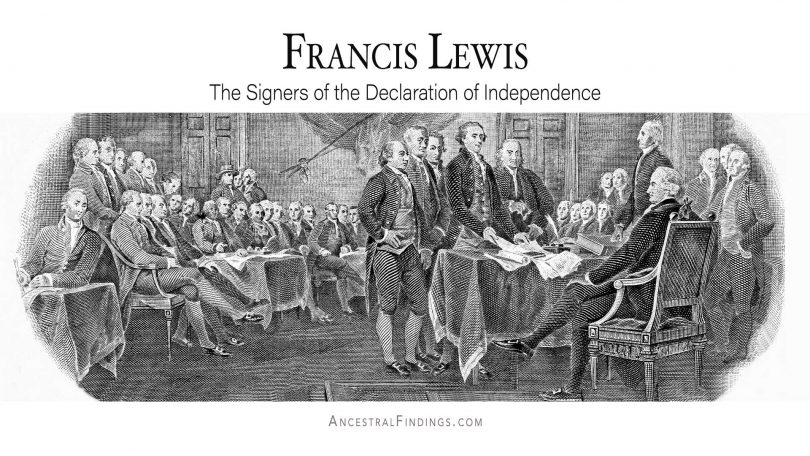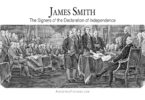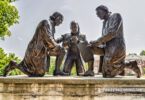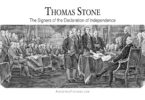A merchant from Wales, Francis Lewis was born in March of 1713 in Llandaff, Wales. He was the only child of his parents, Morgan Lewis and Anne Pettingale. Little is known of his early life, but one of the things that is known is that he was sent to school at the Westminster School in London. Wales is quite far from London, so the fact that he went to school so far away from where he was born is significant. His parents obviously wanted an excellent education for him.
After graduating, Francis went to apprentice at a mercantile house in London. He stayed there until he was twenty-one. At that point, his father had passed away, and Francis inherited some properties from him. Wondering what to do at that point in his young life, Francis decided to sell those properties. Once he did, he used that money he made from the sales to buy some merchandise to set himself up in his own merchant business, and to buy passage on a ship to New York City.
Francis arrived in New York City in around 1734 (or possibly 1735—the exact date of his arrival is not known with certainty). When he arrived, he left some of the merchandise he’d brought with him with a man named Edward Annesley in New York, with the purpose of Edward selling these things for him. Edward became Francis’s business partner. Francis brought the merchandise that he did not leave with Edward to Philadelphia with him. He spent two years in Philadelphia, working the merchant scene, and then went back to New York City.

As a merchant, Francis crossed back and forth across the Atlantic by ship several times. He didn’t just go to Britain, either. He went to several different European ports as part of his career as a merchant, including ports in Russia, Scotland, and Africa. In 1756, while working as a British mercantile agent, he was captured by the French, and imprisoned in France for a time. After being released from prison, he went to his home in America and became immersed in politics.
In New York City, Francis was a member of the Committee of Sixty, as well as a member of the New York Provincial Congress. In 1775, he was selected to be a delegate to the Continental Congress in Philadelphia. He served on the Congress until 1779, during which time he became one of the signers of the Declaration of Independence.
Francis was still serving on the Congress when the Articles of Confederation were written and approved. As such, he also became a signer of the Articles. In his last year on the Congress, he served as the Congress’s Chairman of the Continental Board of Admiralty.
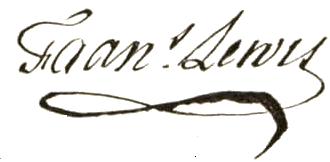
During the American Revolution, Francis’s son Morgan served in the American army, and went into politics after the war, like his father, being elected and appointed to many offices, including the Governor of New York. Francis also helped another son, Francis Lewis Jr. to open a dry goods store named Francis Lewis and Son.
Francis is featured, along with Richard Stockton and John Witherspoon, in the background of John Trumbull’s famous painting, Declaration of Independence, painted in 1819.
In addition to being a merchant and a politician, Francis was also a family man. He married Elizabeth Annesley in 1745. Elizabeth was the business partner of Francis’s business partner, Edward. Francis and Elizabeth had seven children together, three of whom survived childhood. These children were a daughter Anne, and sons Francis Jr and Morgan.
While Francis seems to have had a warm and excellent relationship with his two sons, his daughter Anne was another story. She was the eldest surviving child of her parents, being born in 1848, and she married a Captain of the British Royal Navy named George Robertson. This marriage was adamantly against the wishes of Francis and Elizabeth. Therefore, after the marriage, which Anne went through anyway, she and her new husband left America for England, where they stayed. In fact, Anne never saw or spoke to her family again after that.
In addition to troubles with his daughter, Francis also experienced other family drama during the American Revolution. He had moved his family to an estate he purchased in 1775 in Whitestone, New York, which is today known as Queens. British soldiers destroyed this estate during the Revolution. At the time they destroyed his house, British soldiers also arrested Francis’s wife, Elizabeth. The soldiers deprived her of appropriate amounts of food, or even a change of clothing, for weeks, before she was released in a prisoner exchange. It was the hardships she suffered while a British prisoner that is thought to have crushed her already delicate health—delicate from so many pregnancies. Because of the hardships her health suffered from this experience, she passed away in 1778.
As for himself, Francis Lewis passed away on December 31, 1802 (though his memorial gives the date as 1803). He has a memorial to him at the Trinity Church Cemetery in New York City.
Francis’s granddaughter Marianne Robertson, daughter of his estranged daughter Anne, married the Archbishop of Canterbury in England, who was named John Bird Sumner. John’s brother was the bishop of Winchester. Through his son Morgan, Francis was the ancestor of a line of lawyers in New York City.
Today, there are a few places named after Francis, in tribute of him. One of these places is Francis Lewis High School in Queens. The Francis Lewis School (aka PS 79) in New York City is also named after him. There is a Francis Lewis Boulevard in Queens that goes almost the entire length (north to south) of that particular borough. There is a Francis Lewis Park that is located under the Bronx Whitestone Bridge on the Queens approach side of it. There is also a Masonic Lodge in Whitestone called the Francis Lewis #273 Lodge.

